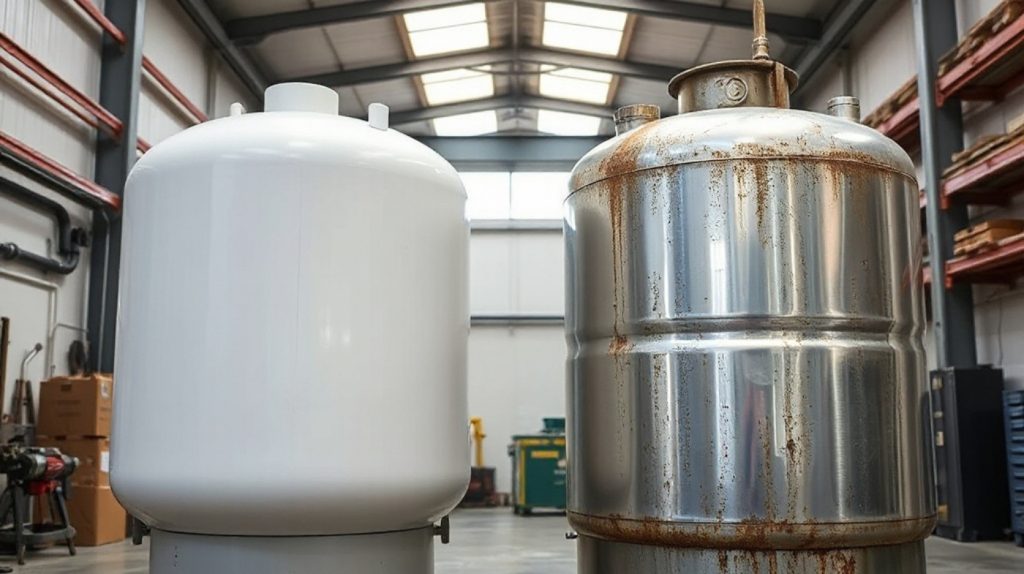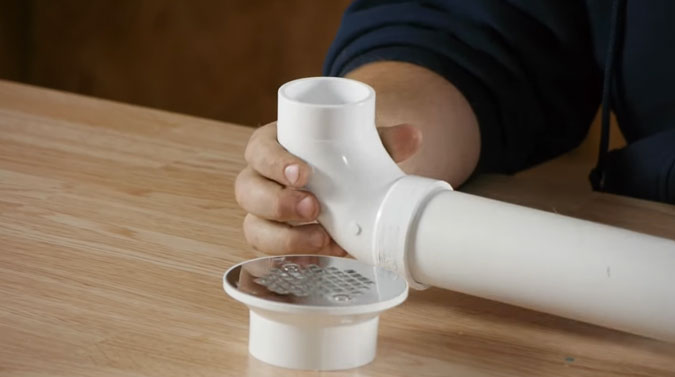Last Updated on May 11, 2025
You’ll find fiberglass pressure tanks offer superior corrosion resistance and require less maintenance compared to steel tanks, which are prone to rust and need regular upkeep.
Fiberglass tanks are also lighter, making transport and installation easier and safer, while steel tanks demand heavy machinery and more labor.
Although fiberglass production uses more energy, its durability reduces replacement frequency. If you want a precise comparison of costs, handling, and environmental factors, keep exploring the key differences.
Key Takeaways
- Fiberglass pressure tanks resist corrosion better, ensuring longer durability compared to steel tanks prone to rust and frequent maintenance.
- Fiberglass tanks are lightweight, making installation and transportation simpler and less costly than heavy steel tanks.
- Maintenance costs are lower for fiberglass tanks due to their corrosion resistance, while steel tanks require regular inspections and protective coatings.
- Fiberglass tanks have lower upfront costs and offer long-term savings by minimizing repairs and replacements compared to steel.
- Steel tanks provide superior structural strength, which may be necessary for high-pressure industrial uses where fiberglass may not suffice.
Durability and Longevity Comparison Between Fiberglass and Steel Tanks
While both fiberglass and steel tanks serve critical roles in pressure storage, their durability and longevity differ considerably due to material properties and environmental interactions.
You’ll find fiberglass tanks excel in corrosion resistance, thanks to their composite construction and quality resin reinforcement, maintaining structural integrity longer under corrosive and environmental stress.
Additionally, fiberglass tanks are known for their lightweight and easy installation, which can simplify handling and setup. In contrast, steel tanks, composed of iron and carbon, are susceptible to rust and corrosion, which compromises material integrity and shortens lifespan despite their inherent strength.
Steel performs well under temperature extremes but demands frequent maintenance to mitigate degradation. Fiberglass tanks undergo rigorous durability testing, ensuring resistance to cracking and chemical attack, ultimately reducing maintenance costs.
Consequently, when corrosion and long-term performance are priorities, fiberglass tanks offer superior durability and extended operational life compared to steel alternatives.
Weight, Installation and Handling Differences
Weight plays an essential role in the handling, installation, and overall logistics of pressure tanks. Fiberglass tanks, being considerably lighter than steel, simplify transport and reduce installation effort.
You benefit from lower shipping costs and easier positioning, especially in confined or elevated spaces. Steel tanks require heavy machinery and robust supports, increasing complexity and expenses.
Additionally, the corrosion resistance of fiberglass tanks minimizes maintenance needs, further reducing long-term operational costs.
| Factor | Fiberglass Tanks | Steel Tanks |
|---|---|---|
| Weight | Lightweight, easier to handle | Heavy, challenging to move |
| Installation | Simplified, less labor-intensive | Complex, needs strong support |
| Handling Safety | Safer, less injury risk | Higher injury risk |
| Transportation | Lower cost, more efficient | More expensive, fuel-intensive |
Choosing fiberglass means streamlined logistics and reduced operational challenges.
Maintenance Requirements for Fiberglass vs. Steel Pressure Tanks
Handling and installation advantages of fiberglass tanks extend into their maintenance profiles, which differ markedly from steel tanks. You’ll find fiberglass tanks require less frequent inspections due to their inherent corrosion and chemical resistance, reducing maintenance complexity.
Unlike steel, which demands regular checks and protective coatings to prevent rust, fiberglass tanks resist environmental degradation but are more prone to algae growth in potable water applications.
Additionally, the lightweight construction of fiberglass tanks facilitates easier handling during routine maintenance. While steel tanks offer superior structural strength and temperature resilience, they need more ongoing maintenance to preserve their integrity.
Repairs on fiberglass tanks, though less common, involve specialized labor and can be more challenging than steel’s straightforward fixes. Your choice should weigh these maintenance demands against operational conditions, ensuring optimized longevity and performance without excessive upkeep.
Cost Analysis: Upfront and Long-Term Expenses
Because upfront investment often shapes project feasibility, understanding the cost distinctions between fiberglass and steel pressure tanks is essential.
Fiberglass tanks typically require lower initial outlays due to simpler materials and manufacturing, plus reduced labor costs from lighter weight. Steel demands higher upfront capital, factoring in costly raw materials and corrosion-resistant treatments.
Additionally, fiberglass tanks can be customized to specific requirements, which can optimize cost-effectiveness in unique applications. customized to specific requirements
Over the long term, fiberglass offers superior value by minimizing maintenance, replacement frequency, and energy expenses. Conversely, steel’s susceptibility to corrosion raises ongoing repair and inspection costs.
Consider these financial aspects:
- Lower fiberglass fabrication and installation costs
- Higher steel material and coating expenses
- Fiberglass’s extended service life reducing replacements
- Maintenance savings from fiberglass corrosion resistance
- Steel’s increased downtime and unplanned repair costs
This analysis highlights fiberglass tanks’ economic advantages across both upfront and operational horizons.
Environmental Impact and Application Suitability of Both Materials
Beyond cost considerations, evaluating the environmental impact and application suitability of fiberglass and steel pressure tanks can guide your material choice.
Fiberglass production is energy-intensive and uses chemicals like styrene, posing environmental risks, while its durability results in long-term persistence and landfill challenges despite recyclability. However, fiberglass tanks have a long lifespan, which contributes to reduced environmental waste over time.
Steel production also consumes substantial energy but benefits from higher recyclability and the potential for repurposing, reducing waste. Application-wise, fiberglass excels in corrosion resistance, chemical compatibility, and weather durability, suiting water treatment and harsh environments with low maintenance needs.
Steel offers superior structural strength and pressure resistance, ideal for high-pressure and industrial applications, although it requires protective coatings to prevent rust.
Ultimately, your decision hinges on balancing environmental impact with specific operational demands, prioritizing either longevity and chemical resistance or structural robustness and recyclability.
Frequently Asked Questions
Can Fiberglass Tanks Be Repaired if Damaged?
You can repair fiberglass tanks effectively if damaged, provided you follow precise steps. Start by sanding and cleaning the surface, then stabilize cracks with drilled holes to avoid spreading. Apply fiberglass resin and matting carefully, ensuring even coverage and proper curing time.
Keep moisture out during repair to maintain adhesion. While DIY is possible, complex damage demands professional skills due to chemical hazards and technique sensitivity. Proper repair preserves tank integrity and longevity.
Do Fiberglass Tanks Require Special Coatings or Treatments?
Think of fiberglass tanks as a fortress needing its armor—you definitely need special coatings. Without UV-resistant gel coats or ANSI/NSF 61-compliant paints, the resin can degrade and lose chemical resistance. These coatings provide corrosion protection and guarantee potable water safety.
You must apply multi-layer, certified coatings and inspect them regularly to prevent cracks or weathering. Proper treatment ensures durability and maintains structural integrity under pressure.
How Do Temperature Extremes Affect Fiberglass Tank Performance?
You’ll find fiberglass tanks typically handle up to 120°F–150°F, but sustained heat above that accelerates resin degradation and risks delamination due to cyclic thermal stress.
High temperatures cause expansion, stressing seals and fittings, especially threaded ones. UV exposure worsens resin breakdown, demanding coatings and frequent inspections.
Operating beyond rated temps voids shortens lifespan. You must monitor pre-charge pressure closely, as heat affects bladder integrity and overall tank performance.
Are There Color Customization Options for Fiberglass Tanks?
Imagine your fiberglass tank not just as a functional vessel but a canvas—you can customize it with various color options.
You can choose colored resin coatings for durability and consistent hues or apply custom paints, especially on smaller diameters. This flexibility lets you integrate tanks aesthetically into diverse environments without compromising performance.
Is Algae Growth a Concern in Fiberglass Tanks Used Outdoors?
Yes, algae growth can be a concern in fiberglass tanks used outdoors because their thin outer layer allows light penetration, encouraging algae development. You’ll need to apply UV-protective coatings or paint the tanks to minimize this risk.
Regular maintenance is essential to control algae buildup. Since fiberglass tanks are lightweight, you can easily move them for cleaning. Taking these steps helps guarantee your tank’s longevity and water quality in outdoor environments.
Durability Over Time: Why Fiberglass Outlasts Steel
When choosing between fiberglass and steel pressure tanks, you’re balancing durability, weight, maintenance, cost, and environmental impact. Fiberglass tanks weigh less and resist corrosion, cutting maintenance like a sharp knife through butter.
Steel tanks offer strength but demand more upkeep and weigh considerably more. Ultimately, your choice hinges on application needs and budget.
By analyzing these factors precisely, you’ll make a decision that stands the test of time without tipping the scales against efficiency.


